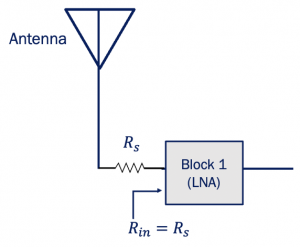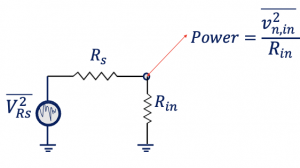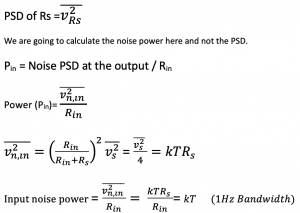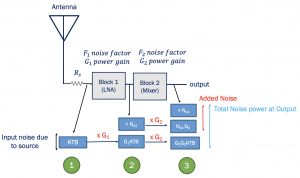
Concept of Receiver Chain Noise Power
Input Noise Power Calculation
For the below diagram, we need to calculate the noise power at the input of the receiver. So assume the given block is our receiver. It can be an LNA or any other block-like bandpass filter. As you see, we have an antenna in the diagram, and Rs is the resistor for the antenna, so let’s assume the block to be an LNA.

To have maximum power from the antenna to the LNA, we have matching circuits, read about the concept of matching circuits. We have Rin going into block 1, which is equal to Rs, to have maximum power transfer. The antenna is our source, and Rs is the impedance of this antenna. We need to find the noise due to this antenna. For now, we assume that our LNA is noiseless, so we don’t have any other noise source except this Rs.
So the circuit would be as shown:

This noise is only due to the source, and we have not taken into account the bandwidth. We measure the power over 1Hz bandwidth. So to find the total power, we need to multiply it by the bandwidth. If B is the bandwidth of our receiver, then we can say that the total input noise power within bandwidth is equal to KTB. The important point to remember here is that this is due to the source noise neglecting all other noises. When calculating the PSD’s density at any receiver’s input, it will be equal to KT and related to only source noise.
Noise Power Analysis in Receiver Chain
Here we include the noise of LNA. In the below-shown diagram, we have ‘No1’, which refers to the output referred to noise power excluding Rs noise, which means it is only the LNA noise. Now we can use the noise figure formula calculated in previous sections:

Noise Power Levels after each Block
Now we have two blocks LNA and Mixer; each of these blocks has a noise factor or noise figure, and also, they have a power gain, for example, 10dB (generally mixer has less gain). The below diagram gives a guide to determine the noise power at the input and the output.
- At the input, the noise power is KTB, as discussed before, and this noise is only produced by the source.
- If we go further, the noise at this point is going to be the input noise times the gain of the LNA. We just refer the gain to the output of LNA plus the noise of the LNA itself. Now we get the total noise at the output. So we could see that the noise increases. The signal goes up as well as the noise, they both increase. In order to control, we have to minimize the No1. If this becomes a lot, we will finally get a bad SNR at the output. If the noise source coming from the LNA is too high, No1, then SNRout is going to be degraded badly, and we won’t be able to detect our signal, so we have to be careful about this noise level.
- At the next stage, when we come to the mixer, we have noise at the input of the mixer from the previous block. Now again, we have to multiply this with the gain of the mixer, which is G2. So we have these noise sources which are coming from the previous stage plus the noise of the mixer itself. Adding all these together, you’re going to have a significant amount of noise at the output of the stage. No2 and No1G2 are the added noise coming from LNA and the mixer. G1G2KTB is just the noise contribution of the source. Similarly, it can be written for further blocks. In summary, we see what happens in our chain at the input we have this noise power, but then this noise power gets added up in the blocks and the block noise.
What is Noise Floor?
If we have total noise at the output, we can refer it to the input. The total input noise is equal to output total noise over the gain of the whole system:

No2, No1G2, and G1G2KTB are the output total noise for this example, and if we divide by the gain of the whole system, we can actually get the input-referred total noise. It is also important to know that we can refer noise to output or input; it doesn’t matter. The noise floor is basically the total output noise, and it means noise considering everything, the noise of the resister, the noise of the LNA, and the noise of the mixer. Everything is referred to as output, basically the last stage, and dividing it by the gain of the whole chain, you’re going to refer it to input, and this concept is called the noise floor. This is an important concept when it comes to designing the receivers.




